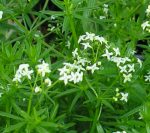
Smooth bedstraw, also known as false baby’s breath, is a herbaceous perennial and member of the madder family, Rubiaceae, that also includes coffee, gardenia, and Pentas. It is native to Europe, Asia and North Africa, but was introduced into the US and now can be found in the Rocky Mountains, Cascade Range, Sierra Nevadas, and Appalachians as well as the Great Lakes area. Plants prefer light shade to full sun and medium moist soil but tolerate less and grow in meadows, fields, open woodland, scrub, grassy slopes, among shrubs, and along paths, roadsides, and railroad tracks.
Description: Growing from a rhizomatous root system, smooth bedstraw has simple to branched stems that are square and swollen at the nodes. They grow up to three feet long but tend to to sprawl unless supported by other vegetation. The leaves are up to one inch long and occur in widely spaced whorls of six to eight. The small white flowers are 1/6 inch wide and appear from late spring to mid summer in loose terminal panicles of cymes up to one foot long. Each flower has a four-lobed corolla with a pair of green fused carpels at its base. The carpels each contain one seed. Plants spread by seed and rhizomes.
Control: Since smooth bedstraw spreads primarily by seed, efforts should be focused on eliminating flowers before they set seed. This can be done by pulling , cutting or mowing the plants. Seedlings should be pulled as they appear and older plants dug being careful to get all the whole root system. Alternatively, the entire area can be covered with a dense mulch such as newspaper or cardboard for a growing season. In severe cases, an herbicide containing aminopyrlid, such as Milestone and Forefront R&P, can be used but will kill other broad-leafed plants; an herbicide containing glyphosate, such as Round Up, is also effective especially when applied in late summer but will kill all the vegetation.